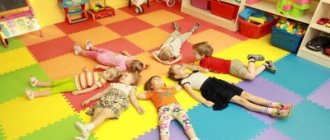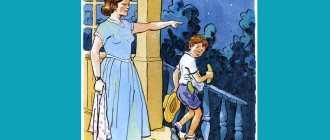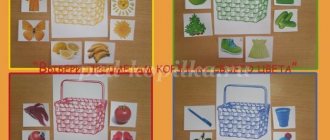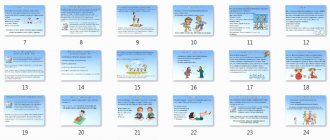For a child, play is not only a pleasant way to throw out his energy, but also the main way of learning about the world. Educational games in kindergarten with various objects have a significant impact on the development of the child as a full-fledged individual. For such games, a variety of objects are used: sticks, twigs, hammers, spoons, nets, etc. They are aimed at developing the child’s memory, logic, spatial thinking, and imagination.
Types of educational games in kindergarten:
- didactic games for junior and middle groups;
- outdoor games for preschoolers of all ages;
- role-playing games.
Examples of activities
What kind of item
The child is given a bag filled with various items. Then the baby is asked to take one toy out of it and name it. The teacher must help the child correctly describe this object.
Finger games
The essence of finger games is often to alternately bend the fingers. The teacher says a counting rhyme, and the kids bend their fingers. Thus, the fine motor skills of children's fingers develop very well.
Letters around me
The teacher asks the children to carefully examine with their eyes the room in which they are located. Then the children must take turns naming the objects in the room in alphabetical order. This game can be played in older groups, where children already know the letters of the alphabet.
Paintings
The teacher shows the children a picture and names its author. Then the kids must find objects on the canvas with a certain letter. Next, you need to remove the image and ask each child to remember the previously mentioned objects.
Which plant is gone?
Several pots with indoor flowers are placed on the table. Children should look at them carefully and remember. The teacher tells the children to close their eyes and removes one plant from the table. When the children open their eyes, they should remember which plant was previously on the table.
6. Games with cards, for example, learning shapes and colors, cards with numbers, etc.
Outdoor activities
“Run to me!”
The game requires flags of four colors. The child takes the flag of the color he likes. The teacher has all four flags in his hands. Then the teacher shows the first flag and says the phrase “Run to me!” Those children who are holding a flag of the same color in their hands should run up to the leader of the game.
"Hares and the wolf."
Among the guys, one is chosen to be the “wolf”. The teacher recites a poem, and the children pretend to be hares: The hares are jumping across the meadow, nibbling the grass, listening to Is there a wolf coming? After finishing the teacher’s words, the “wolf” tries to catch the “hares”, and they must run away into their “holes”.
Game as a method of teaching and education in kindergarten.
Children's play is a means of actively enriching the personality, since it represents a free choice of various socially significant roles and positions, and provides the child with activities that develop his unlimited capabilities and talents in the most appropriate use.A game is a type of unproductive activity, the motive of which lies in the process itself, and the goal is to obtain satisfaction from the player.
The game can be understood in different ways:
— game is a special type of human activity;
- the game is a means of influencing the players (since it is specially organized and has a specific goal);
-game - a special set of rules that require their execution;
-game is a special way of conditionally appropriating the world;
-game- as a form of pedagogical activity.
Any game can implement the entire range of the following functions:
1. emotionally developing function;
2. diagnostic function - hidden talents are revealed;
3. relaxation function - excessive tension is reduced;
4. compensatory function - gives a person what he lacks;
5. communicative function - is an excellent means of communication;
6. function of self-realization - serves as a means to achieve desires and realize opportunities;
7. sociocultural function - during the game a person masters sociocultural norms and rules of behavior;
8. therapeutic function - can serve as a means of treating human mental disorders.
Organizing a high-quality, useful game is a complex and painstaking process. The teacher must master this art (precisely formulate the rules, organize the space, choose the appropriate time, determine the plot of the game, select the game props and competently organize the beginning and ending) When organizing the game, he must choose one or two functions as the main goal that will be him the most important.
The role of play in education in kindergarten
When starting to organize play in kindergarten, educators rely on the already achieved level of development of the children, their inclinations, habits, abilities, and then systematically rebuild the existing interests of the children into the desired ones, increasing the requirements for them, patiently and persistently working on their spiritual growth.
It is important for kindergarten teachers to rely on the role of play in education. But they should not equate play in a child only with entertainment. Let some games be fun entertainment, and others a favorite pastime during leisure hours. It’s good if no one is bored, everyone is busy with something, an interesting game. But not only this determines the inextricable connection between play and the entire process of education. Much depends on the methodology and technique of their organization, on the style of play, and most importantly on its quality. Only in this way can the role of play in education be realized.
The role of play in education is that it is in games that children reveal their positive and negative qualities and the teacher gets full opportunity to properly influence everyone together and each individual.
If the games really captivate the children, then the teacher also has at his disposal the necessary punitive measures, up to and including expelling children from the game for violating the rules or for bad behavior.
Despite the great role of play in education, it cannot be isolated, considered a mono-means, or expected to educate children through games alone.
The role of play in instilling the right attitude towards work is great. Very often it is possible to combine a game so successfully with the labor process that it will decorate the work, cultivate a constant love for it, and help to successfully master the skill.
The educational role of the game is that games teach children to live and work in a team, to take into account the interests of their comrades, to come to their rescue, to follow established rules, and to fulfill the requirements of discipline.
When planning work for the school year, educators set themselves goals and objectives through which they will develop the creative abilities of students, the physical capabilities of children, and help create a friendly children's team, i.e. make the most of the role of play in education. That is why games in all their diversity are widely used in educational work with children.
Most psychologists and teachers consider play in preschool age as an activity that determines the child’s mental development, as a leading activity, during which mental new formations arise.
Play is the most accessible type of activity for children; it is a way of processing impressions and knowledge received from the surrounding world. Already in early childhood, a child has the greatest opportunity in play, and not in any other activity, to be independent, to communicate with peers at his own discretion, to choose toys and use different objects, to overcome certain difficulties logically related to the plot of the game, its rules.
The goal of play therapy is not to change the child or remake him, not to teach him any special behavioral skills, but to give him the opportunity to “live” situations that excite him in the game with the full attention and empathy of an adult.
Using gaming technologies in the educational process, an adult needs to have empathy, goodwill, be able to provide emotional support, create a joyful environment, encourage any invention and fantasy of the child. Only in this case will the game be useful for the development of the child and the creation of a positive atmosphere of cooperation with adults.
At first they are used as separate game moments. Game moments are very important in the pedagogical process, especially during the period of adaptation of children in a child care institution. Starting from two to three years old, their main task is the formation of emotional contact, children’s trust in the teacher, the ability to see in the teacher a kind person, always ready to help (like a mother), an interesting partner in the game. The first play situations should be frontal, so that no child feels deprived of attention. These are games like “Round Dance”, “Catch-Up” and “Blowing Soap Bubbles”.
In the future, an important feature of gaming technologies that educators use in their work is that gaming moments penetrate into all types of children’s activities: work and play, educational activities and play, everyday household activities related to the implementation of the regime and play.
Role-playing game is one of the creative games. In role-playing games, children take on certain functions of adults and, in playful, imaginary conditions specially created by them, reproduce (or model) the activities of adults and the relationships between them. In such a game, all the mental qualities and personality traits of the child are most intensively formed.
Children's independence in role-playing games is one of its characteristic features. Children themselves determine the theme of the game, determine the lines of its development, decide how they will reveal the roles, where the game will unfold. Uniting in a role-playing game, children choose partners of their own free will, set the game rules themselves, monitor implementation, and regulate relationships. But the most important thing in the game is the child embodying his view, his ideas, his attitude towards the event that he is acting out.
The main component of a role-playing game is the plot, which is the child’s reflection of certain actions, events, relationships from the life and activities of others. At the same time, his game actions (cooking dinner, turning the steering wheel of a car, etc.) are one of the main means of realizing the plot.
The plots of the games are varied. They are conventionally divided into:
1. Household (family games, kindergarten)
2. Production, reflecting the professional work of people (hospital, store, hairdresser)
3. Public (Birthday, library, school, flight to the moon)
The content of the role-playing game is embodied by the child through the role he takes on. A role is a means of realizing the plot and the main component of a role-playing game.
Directing play is a type of creative play. It is close to the role-playing game, but differs from it in that the characters in it are not other people (adults or peers, but toys depicting various characters. The child himself gives roles to these toys, as if animating them, he himself speaks for them different voices and he himself acts for them. Dolls, teddy bears, bunnies or soldiers become the protagonists of the child’s game, and he himself acts as a director, managing and directing the actions of his “actors”, which is why such a game is called directorial.
The integrated use of gaming technologies for different purposes helps prepare a child for school. From the point of view of the formation of motivational and emotional-volitional readiness for school, each play situation of communication between a preschooler and adults, with other children is for the child a “school of cooperation”, in which he learns to both rejoice in the success of a peer and calmly endure his own failures; regulate their behavior in accordance with social requirements, and equally successfully organize subgroup and group forms of cooperation. The problems of developing intellectual readiness for school are solved by games aimed at developing mental processes, as well as special games that develop elementary mathematical concepts in a child, introduce him to the sound analysis of words, and prepare his hand for mastering writing.
Thus, gaming technologies are closely related to all aspects of the educational work of a kindergarten and the solution of its main tasks. However, there is an aspect of their use that is aimed at improving the quality of the pedagogical process by solving situational problems that arise during its implementation. Thanks to this, gaming technologies turn out to be one of the mechanisms for regulating the quality of education in kindergarten: they can be used to level out negative factors that influence the decrease in its effectiveness. If children are systematically engaged in play therapy, they acquire the ability to manage their behavior, tolerate prohibitions more easily, become more flexible in communication and less shy, cooperate more easily, express anger more “decently,” and get rid of fear. Their play activities begin to be dominated by role-playing games depicting people’s relationships. Folk games with dolls, nursery rhymes, round dances, and joke games are used as one of the effective types of game therapy. Using folk games in the pedagogical process, educators not only implement the educational and developmental functions of gaming technologies, but also various educational functions: they simultaneously introduce students to folk culture. This is an important area of the regional component of the kindergarten educational program, which is still insufficiently developed.
In theatrical games (dramatization games), the actors are the children themselves, who take on the roles of literary or fairy-tale characters. Children do not invent the script and plot of such a game themselves, but borrow it from fairy tales, stories, films or plays. The task of such a game is to, without deviating from the well-known plot, reproduce the role of the character assumed as accurately as possible. The heroes of literary works become characters, and their adventures, life events, and changes by children’s imagination become the plot of the game.
The peculiarity of theatrical games is that they have a ready-made plot, which means the child’s activity is largely predetermined by the text of the work. Theatrical play is a rich field for children's creativity. Creative role-playing in a theatrical play is significantly different from creativity in a role-playing game. In role-playing games, the child is free to convey the image of role-playing behavior. In a theatrical play, the image of the hero, his main features, actions, and experiences are determined by the content of the work. The child's creativity is manifested in the truthful portrayal of the character. To implement it, the child must understand what the character is like, why he acts this way, and imagine his state and feelings. To play the role, the child must master a variety of visual means (facial expressions, body movements, gestures, expressive and intonation speech). Theatrical and play activities enrich children in general with new impressions, knowledge, skills, develop interest in literature and theater, form dialogical, emotionally rich speech, activate the vocabulary, and contribute to the moral and aesthetic education of each child.
Thus, the phenomenon of play should be treated as a unique phenomenon of childhood. Play is not only an imitation of life, it is a very serious activity that allows a child to assert himself and realize himself. By participating in various games, the child chooses characters that are closest to him and correspond to his moral values and social attitudes. The game becomes a factor in the social development of the individual
Conclusion
So, play occupies an important place in the organization of children’s lives. Games are repeated daily, and on “their shoulders”, in favorable conditions, the children’s team grows and strengthens, with its inherent diversity of interests, the joy of communication, and social life skills. The games clearly show the level of social education, moral qualities, social behavior skills of children, and the level of their interests.
The process of play in preschoolers requires the involvement of the teacher, but with different goals, at different levels of development of relations between children. When a teacher enters the center of a child’s life - the circle of relationships that develop between children, then it is easy for him to navigate the organization of the game. From this follows the conclusion that it is necessary to master the skill of managing the game to such an extent that you are ready at any moment to show the children the game, play it with them, evaluate their achievements in mastering the rules and the still small but still existing technique of the game. For a child, mastering a new game means gaining new experiences. When the children master the game, then we will say: “Now you already know how to play yourself.” The more contact he has with children, the more often an adult acts as a connoisseur and advisor. The assessment should be made in a friendly manner, avoiding the tone of instruction or order.
We take the game as the life of children with all the contradictions, feelings, experiences, actions it contains, in general, with manifestations of an integral human personality. If for a child play is true life, then by organizing this life well and wisely we get great opportunities in raising children.
LIST OF REFERENCES USED
1. Azarov YL. Play and work. - M., 1973. Azarov YL. The art of education. - M., 1979.
2. Anikeeva N.P. Education by playing. - M., 1987.
3. Gazman O.S. etc. To school - with a game. - M., 1991.
4. Guruzhapov VA. Questions of examination of educational technologies // Psychological science and education. 1997. No. 2.
5. Zanko S.F. et al. Game and learning. - M., 1992.
6. Zimnyaya A. N. Pedagogical psychology - M., 2000.
7. Games - education, training, leisure... / Ed. V.V. Letrusinsky. - M., 1994.
8. Ilyina TA. Pedagogy. - M., 1984.
9. Clarin M.V. Pedagogical technology. - M., 1989.
10. Likhachev B.T. Pedagogy. - M., 1992.
11. Minkin E. M. From game to knowledge. - M., 1983.
12. Nikitin B.P. Steps of creativity, or educational games. - M, 1990.
13. Pedagogy / Ed. Yu.K. Babansky. - M., 1983.
14. Pedagogical creativity at school (from the experience of Russian teachers) / Ed. V.F. Krivosheeva - M., publishing house of the Scientific Research Institute of Schools of the RSFSR Ministry of Defense, 1992. - 114 p.
15. Samukina N.V. Organizational and educational games in education. - M.: Public Education, 1996.
16. Stolyarenko V.A. Educational psychology - Mn. ,2000.
17. Yakovlev N.M., Sokhor A.M. Lesson methods and techniques at school. - M., 1985. - 163 p.
18. Yanovskaya. M.G. Creative play in educating primary schoolchildren. - M., 1974.
Role-playing educational games
"The Hermit Crab and the Rose"
With the help of decorations, the illusion of a sunny sea coast is created. The main character is the hermit crab. He is completely alone, so the sea and the sun do not please him. He accidentally meets dolphins, who advise him to get a best friend. The hermit crab first tries to befriend the jellyfish, but she turns out to be indifferent to his need for friendship. Other sea inhabitants (crabs and moray eels) also do not want to see a friend in his face. Completely desperate, the crayfish swims to the algae and meets a beautiful sea rose there. He invites the rose to become his friend, and she cannot refuse him. At the end, the cancer and the rose dance a beautiful dance together as a sign of friendship.
Video on the topic
Features of educational games in the younger group
Game is a unique mechanism that allows you to develop various qualities in a child. Thus, educational games in the younger group allow you to develop the child’s psyche, attention, fine motor skills, and logical thinking. Educational games for the youngest children have as their main goal the overall development of the child and his preparation for the next stage of development - preschool age.
In early preschool age, it is important to teach a child abstract thinking, logical analysis, planning and forecasting, and correct perception of the surrounding reality. Developmental games for preschool children are based on careful study and characterization of objects. Children are offered puzzles, mosaics, and various geometric shapes that develop the child’s spatial orientation. As a rule, in a preschool institution, games are played in groups, when children work together to solve assigned problems. Doing tasks in a group allows the child to learn how to work in a team, learn to coordinate their actions with the actions of other children, thereby learning the basics of relationships.
Educational games in kindergarten in the younger group are selected taking into account the developmental characteristics of children 3-5 years old. At this age, children are characterized by a certain independence and intolerance to adult help during games. The child strives to complete the task independently. As a rule, being under the care of parents, the child does not receive the same freedom of action as in kindergarten, where the child, being in a group of peers, cannot receive full attention from the teacher. The main task of the teacher is to monitor the child’s actions, analyze his abilities, acquired skills and abilities, as well as correct the educational process so that each child in the group receives comprehensive development.
Special attention in teaching and raising children in kindergartens is paid to physical development. Educational games in kindergarten are organized so that the child moves during the game and receives a certain physical activity. One of the exciting activities for children in the younger group is playing with suspended multi-colored paper butterflies, which will only be able to “fly” when the children blow on them with all their might. In this simple and uncomplicated game, the child develops coordination and lungs. The game can be modified and supplemented with the task of making the butterflies fly in a certain sequence: first red, then yellow, then blue.
pros
- Educational games allow you to maximize the work of each child in the team.
- Such games instill interest and respect for specialists in various professional fields.
- They introduce the rules of behavior of an intelligent person in society.
- They help children organize their own play activities (develop a play plot, assign roles for play, etc.).
- They form normal relationships between your son or daughter and the team, and develop communicative character traits in him.
- They develop the ability to perform a certain set of actions with objects of different shapes and sizes.
- Trains fine motor skills of the hands.
- Children are taught to distinguish objects from each other according to certain characteristic features.
- Helps you quickly memorize the names of objects.
- They teach you how to perform a simple set of arithmetic operations.
- Reinforce knowledge about geometric shapes and their properties.
- Helps learn the alphabet.
- Develop visual memory, auditory memory, imaginative thinking and observation.
- Expand vocabulary.
- They learn to focus and concentrate on one subject.
Educational games in kindergarten are very emotional, interesting and exciting. They contribute to the development of spatial thinking, creativity, and logic. These entertainments with kids help break down communication barriers and make children liberated and independent. Educational activities for kids are a reflection of the real world. With their help, children learn to live.
Educational games for children of the senior group of kindergarten card file (senior group) on the topic
Educational games for children in the senior group of kindergarten
Games aimed at developing logic in senior preschoolers
Game "Find options".
Goal: to develop logical thinking and intelligence.
Game material and visual aids: cards with the image of 6 circles.
Description: give the child a card with a picture of 6 circles, ask them to paint them in such a way that there are equal numbers of filled and unshaded figures. Then view and calculate all painting options. You can also hold a competition to see who can find the largest number of solutions.
Game "Wizards".
Goal: to develop thinking and imagination. Game material and visual aids: sheets depicting geometric shapes.
Description: Children are given sheets depicting geometric shapes. Based on them, it is necessary to create a more complex drawing. For example: rectangle - window, aquarium, house; circle - ball, snowman, wheel, apple. The game can be played in the form of a competition: who can come up with and draw the most pictures using one geometric figure. The winner is awarded a symbolic prize.
Game "Collect a flower".
Goal: to develop thinking, the ability to analyze and synthesize.
Game material and visual aids: cards depicting objects related to the same concept (clothing, animals, insects, etc.).
Description: each child is given a round card - the middle of the future flower (one - a dress, the second - an elephant, the third - a bee, etc.). Then the game is played in the same way as in lotto: the presenter distributes cards with images of various objects. Each participant must assemble a flower from cards, the petals of which depict objects related to the same concept (clothing, insect, etc.).
Game "Logical endings".
Goal: to develop logical thinking, imagination, ability to analyze.
Description: children are asked to complete the sentences:
• Lemon is sour, and sugar... (sweet).
• You walk with your feet, but throw... (with your hands).
• If the table is higher than the chair, then the chair... (below the table).
• If two are more than one, then one... (less than two).
• If Sasha left the house before Seryozha, then Seryozha... (left later than Sasha).
• If the river is deeper than a stream, then the stream... (smaller than a river).
• If the sister is older than the brother, then the brother... (younger than the sister).
• If the right hand is on the right, then the left hand... (on the left).
• Boys grow up to become men, and girls... (women).
Game "Ornament".
Goal: to develop logical thinking and the ability to analyze.
Game material and visual aids: 4-5 groups of geometric shapes (triangles, squares, rectangles, etc.), cut out of colored cardboard (figures of one group are divided into subgroups differing in color and size).
Description: invite the child to consider how you can create ornaments from geometric shapes on a playing field (sheet of cardboard). Then lay out the ornament (according to a model, according to your own plan, under dictation), using concepts such as “right”, “left”, “above”, “below”.
Game "Helpful - Harmful."
Goal: to develop thinking, imagination, ability to analyze.
Description: consider any object or phenomenon, noting its positive and negative sides, for example: if it rains, this is good, because plants drink water and grow better, but if it rains for too long, this is bad, because plant roots can rot from excess moisture.
Game “What did I wish for?”
Goal: develop thinking.
Game material and visual aids: 10 circles of different colors and sizes.
Description: lay out 10 circles of different colors and sizes in front of the child, invite the child to show the circle that the teacher ordered. Explain the rules of the game: when guessing, you can ask questions, only with the words more or less. For example:
- Is this circle bigger than red? (Yes.)
- Is it bigger than blue? (Yes.)
- More yellow? (No.)
- Is this a green circle? (Yes.)
Game "Plant Flowers".
Goal: develop thinking.
Game material and visual aids: 40 cards with images of flowers with different petal shapes, sizes, and core colors.
Description: invite the child to “plant flowers in the flowerbeds”: in a round flowerbed all flowers with round petals, in a square flowerbed - flowers with a yellow core, in a rectangular flowerbed - all large flowers.
Questions: what flowers were left without a flowerbed? Which ones can grow in two or three flower beds?
Game "Group by characteristics."
Goal: to consolidate the ability to use generalizing concepts, expressing them in words.
Game material and visual aids: cards with images of objects (orange, carrot, tomato, apple, chicken, sun).
Description: place cards in front of the child with images of different objects that can be combined into several groups according to some characteristic. For example: orange, carrot, tomato, apple - food; orange, apple - fruits; carrots, tomatoes - vegetables; orange, tomato, apple, ball, sun - round; orange, carrots - orange; sun, chicken - yellow.
Game "Remember faster."
Goal: develop logical thinking.
Description: invite the child to quickly remember and name three round objects, three wooden objects, four pets, etc.
Game "Everything that flies."
Goal: develop logical thinking.
Game material and visual aids: several pictures with various objects.
Description: invite the child to select the proposed pictures based on the named characteristic. For example: everything is round or everything is warm, or everything is animate that can fly, etc.
Game "What is it made of"
Goals: develop logical thinking; consolidate the ability to determine what material an object is made of.
Description: the teacher names some material, and the child must list everything that can be made from it. For example: tree. (You can use it to make paper, boards, furniture, toys, dishes, pencils.)
Game “What Happens...”
Goal: develop logical thinking.
Description: invite the child to take turns asking each other questions in the following order:
- What is big? (House, car, joy, fear, etc.)
- What is narrow? (Path, mite, face, street, etc.)
— What happens to be low (high)?
— What is red (white, yellow)?
— What is long (short)?






